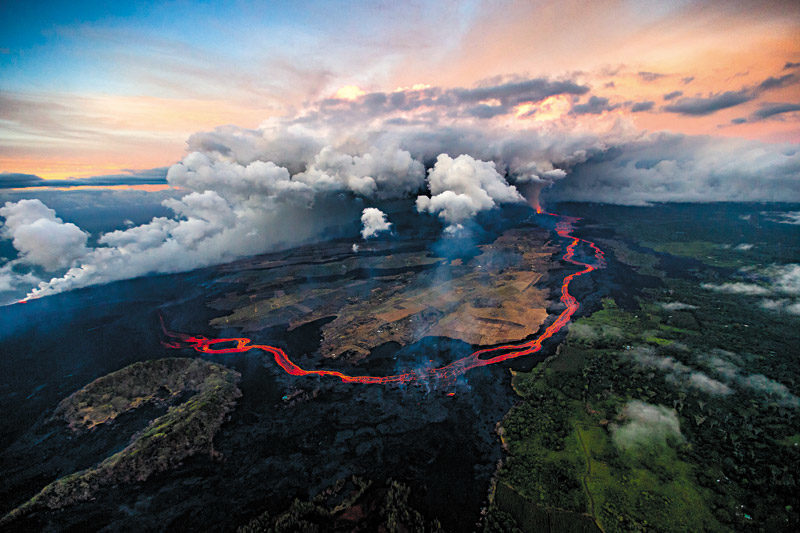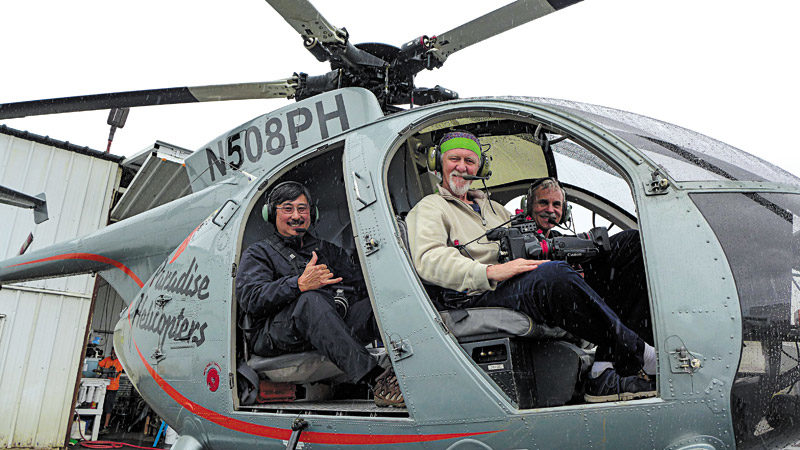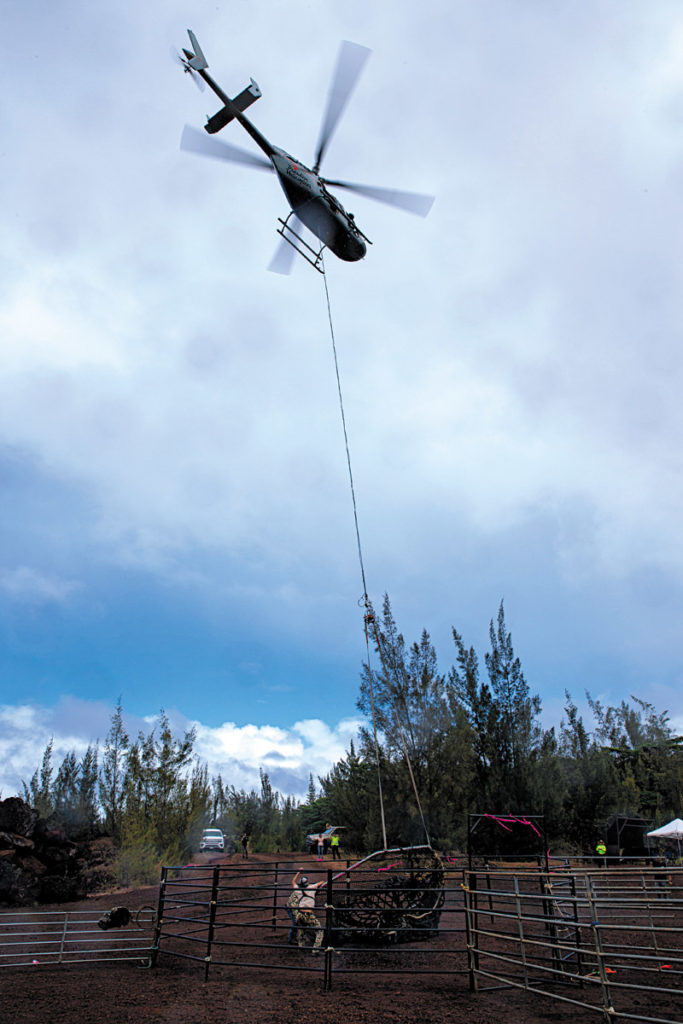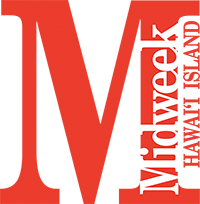The Eruption Seen Around The World

The Kīlauea eruption zone
BRUCE OMORI PHOTO
Bruce Omori, Mick Kalber and Calvin Dorn spent a good part of 2018 in the air documenting Kīlauea’s eruption, and the images and videos they captured impacted residents on the Big Island and spectators all over the globe.
A year ago this month, the ground split open and lava spewed from the earth in residential neighborhoods, forcing thousands to evacuate their homes along the Big Island’s lower East Rift Zone. It was the devastating last days of an eruption that has been constantly changing the landscape since the early ’80s.
The community joined together to help where they could, including three friends — a photojournalist, a videographer and a helicopter company CEO — who would lend their talents to provide daily updates to the world and to residents in the affected areas.
Though photojournalist Bruce Omori, owner of Extreme Exposure Fine Art Gallery, and Mick Kalber, videographer and owner of Tropical Vision Video, have made a career out of documenting Kīlauea for decades, the devastation of the 2018 eruption was like nothing they had ever seen before.
Calvin Dorn, CEO of Paradise Helicopters, has donated many hours of flight time to island residents dealing with lava inundation over the years. The three — Omori, Kalber and Dorn — previously joined forces on numerous occasions, including the 2011 Nāpau fissure eruption; the 2008 Royal Gardens flash flow; the evacuation of Royal Gardens’ last resident, Jack Thompson; the 2014 Pāhoa flow, and many others.

Mick Kalber, Bruce Omori and Calvin Dorn capture the Kīlauea eruption from 2018.
PHOTO COURTESY HOT SEAT HAWAI‘I
“When the 2014 flow stopped short of Pāhoa, Bruce and I continued to fly with Paradise Helicopters, keeping tabs on Kīlauea’s activities as she erupted in and around Pu‘u ‘Ō‘ō,” says Kalber, who was an award-winning videographer/ editor/producer for TV news in Omaha and Denver before making Hawai‘i his home in 1984. He has since produced 10 award-winning documentaries on the world’s most active volcano.
Kalber and Omori would go airborne weekly and had witnessed the collapse of Pu‘u ‘Ō‘ō in April last year. They knew something would happen downslope, just not precisely where. So when the ground broke open in Leilani Estates, which just so happens to be where Kalber and his wife’s home was, the two took to the air again that very afternoon.
“The flow was sluggish at first, and jumped from fissure to fissure, briefly erupting at the end of Kūpono Street, where my house is,” recalls Kalber. “Then, on May 6, lava poured from fissure six and flowed almost due north, just two blocks away. That area would be where the biggest vent, fissure eight, would break out later and send lava eight miles downslope. It destroyed Kapoho Beach Lots, the tide pools, Vacationland, Ahalanui Hot Ponds, Kua O Ka Lā Hawaiian Language Charter School, and hundreds of homes and acres of property.”

Bruce Omori, Mick Kalber and Calvin Dorn pause for a photo.
KATIE YOUNG YAMANAKA PHOTO
In addition to documenting the eruption and supplying mainland and international news outlets with up-to-date information, Kalber and Omori quickly realized that no one was giving evacuated residents information on the progress of the flow and the status of their homes.
“We found, much to our surprise, that we became two of the news sources for people,” says Kalber.
When Dorn, who got his flight training with the Marines, visited “The Hub,” a place for displaced residents to gather, he realized how badly the public needed not only information but also closure, so he set up a TV for Omori and Kalber’s photos and videos to be streamed.
“Mick and Bruce were up and flying almost every day and did not rest until they had posted pictures and videos to share with those whose lives had been disrupted by the lava flows,” says Dorn. “All of us at Paradise were proud to get them up in the air to get that information to the public.”

KIA Hawai‘i and Paradise Helicopters partnered for a cattle rescue mission during the Kīlauea eruption. BRUCE OMORI PHOTO
The challenges were many, however. The flow often created its own weather, making many areas inaccessible or difficult to shoot. The biggest challenge was the temporary flight restriction imposed by Civil Defense and the FAA.
“It restricted us to flying at or above 3,000 feet,” Kalber explains. “From that altitude, video and stills are difficult to stabilize, turbulent air adds to the problem, and gases, rain, smoke and heat distort images. Then, there was the breathing. The (sulfur dioxide), even at 3,000 feet, was devastating. Our lungs, heads and stomachs all hurt from taking in the gas.”
As restrictive as the TFR was, however, Omori adds that having a collaborative partnership with Paradise Helicopters was priceless.
“It enabled us to have a perspective over the entire lower east rift zone and gave us the ability to fly to where things were occurring at a moment’s notice,” he says.
Omori has spent much of his time as a photographer documenting Kīlauea’s volcanic activity, though he is asthmatic and allergic to sulfur. Forced to spend much of his youth hanging out on the school bus while his classmates explored the volcano, Omori entered adulthood with a burning desire to see lava up close. In 2005, he left behind an engineering career on O‘ahu to pursue his passion back home in Hilo, never realizing at the time how much of an impact his professional work would make on the community.
“On countless occasions, people would approach me, expressing appreciation for taking the last photo of their homes — and while they were grief-stricken, they always said that the photos helped give them a sense of closure,” says Omori, whose heart still goes out to the residents of Puna. “Thousands lost their homes. Some were displaced because of the close proximity to the fissures, while others were isolated or downwind of the flows.”
The affected, he says, also included dozens of animals. That’s why, in addition to shooting footage of homes and lava from above, Omori found himself part of several rescues last year, like air-lifting livestock out of inundated areas and other times when he had to put his camera down and lend a hand instead.
One of the most memorable for Omori was helping Kapoho resident Cosette Bonjour retrieve personal items from her home just hours before it was taken by lava.
“She had been on the mainland recovering from foot surgery, and once she found out the eruption was headed towards Kapoho, she rushed home only to be turned away by officials at the Four Corners intersection,” he says. “As a last resort, she drove to the hangars, and I just happened to be packing up my gear from our early morning charter. She told me her story, trembling, with tears in her eyes. After numerous calls to the mayor, HFD and Civil Defense, we got approval to go in.
“It was a short window of time but her only opportunity to return to her home. By the time everything was in place, lava had begun entering Kapoho Bay. An immense plume of haze was blowing over her home, necessitating a landing on exposed rocks next to the sea. Because of the risky landing spot, the pilot, Rob, stayed with the aircraft, handed Cosette two trash bags and a little suitcase and told me to go with her. We had 15 minutes to grab whatever she wanted to save.”
The experience of last year’s eruption left Omori with a deep sense of sadness, but also an appreciation for the process by which the islands were formed.
“I have a deep gratitude for our community, as everyone pulled together to help each other out in any way they could,” he says.
The 2018 eruption was also extremely personal for Kalber.
“The whole thing was totally surreal,” he says. “For two months straight, I watched as fissure eight poured out tons and tons of lava. Watching the flow slowly encroaching toward our property was maddening. That shook me … it’s the epitome of powerlessness. Several times lava breached the walls of the lava river and headed our way. As it worked out, our place survived. We are now
on the last through street in Leilani. The lava stopped just 500 feet from the back of our lot. Mentally and emotionally, last year’s eruption took its toll. We wondered if it would ever stop. But having shot Kīlauea’s eruptions for 35 years, I knew it wouldn’t last forever.”
Omori and Kalber would end up flying 70-80 days of last year’s 100-day eruption thanks to their partnership with Dorn and Paradise Helicopters.
In retrospect, Omori says, “I saw the eruption as a once-in-a-lifetime geological event, and although it was terribly destructive, it gave our generation a front row seat to an epic display of our planet’s creative forces. It’s my hope that the photos and stories from this will inspire the next generation of geologists, volcanologists, scientists, photographers and journalists.”


